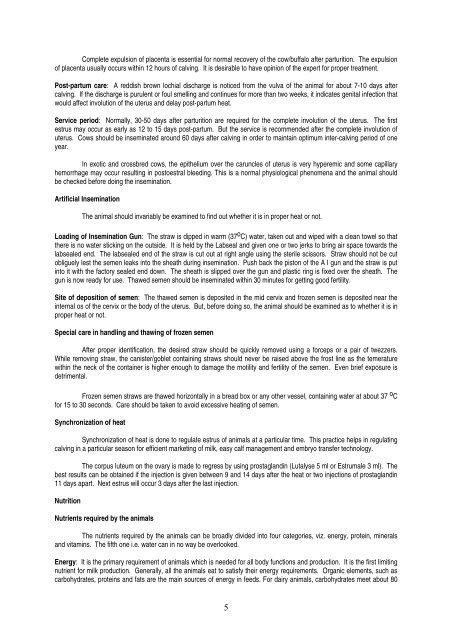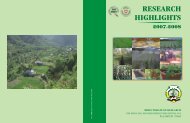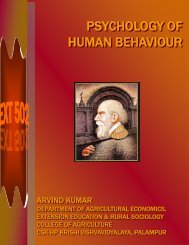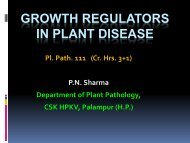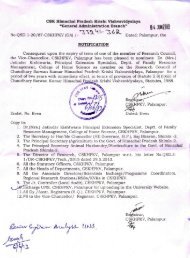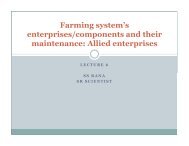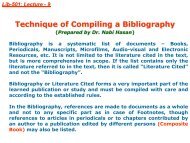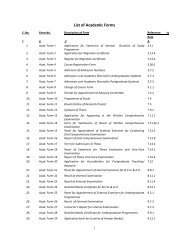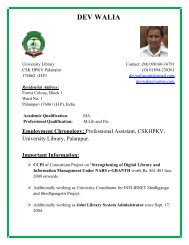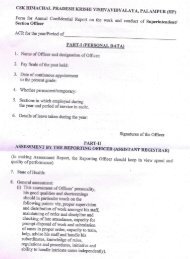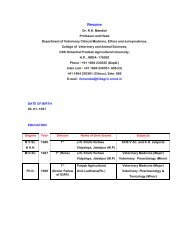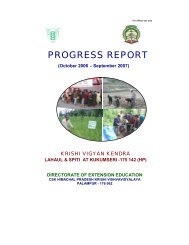animal production - CSK Himachal Pradesh Agricultural University ...
animal production - CSK Himachal Pradesh Agricultural University ...
animal production - CSK Himachal Pradesh Agricultural University ...
Create successful ePaper yourself
Turn your PDF publications into a flip-book with our unique Google optimized e-Paper software.
Complete expulsion of placenta is essential for normal recovery of the cow/buffalo after parturition. The expulsion<br />
of placenta usually occurs within 12 hours of calving. It is desirable to have opinion of the expert for proper treatment.<br />
Post-partum care: A reddish brown lochial discharge is noticed from the vulva of the <strong>animal</strong> for about 7-10 days after<br />
calving. If the discharge is purulent or foul smelling and continues for more than two weeks, it indicates genital infection that<br />
would affect involution of the uterus and delay post-partum heat.<br />
Service period: Normally, 30-50 days after parturition are required for the complete involution of the uterus. The first<br />
estrus may occur as early as 12 to 15 days post-partum. But the service is recommended after the complete involution of<br />
uterus. Cows should be inseminated around 60 days after calving in order to maintain optimum inter-calving period of one<br />
year.<br />
In exotic and crossbred cows, the epithelium over the caruncles of uterus is very hyperemic and some capillary<br />
hemorrhage may occur resulting in postoestral bleeding. This is a normal physiological phenomena and the <strong>animal</strong> should<br />
be checked before doing the insemination.<br />
Artificial Insemination<br />
The <strong>animal</strong> should invariably be examined to find out whether it is in proper heat or not.<br />
Loading of Insemination Gun: The straw is dipped in warm (37 o C) water, taken out and wiped with a clean towel so that<br />
there is no water sticking on the outside. It is held by the Labseal and given one or two jerks to bring air space towards the<br />
labsealed end. The labsealed end of the straw is cut out at right angle using the sterile scissors. Straw should not be cut<br />
obliguely lest the semen leaks into the sheath during insemination. Push back the piston of the A I gun and the straw is put<br />
into it with the factory sealed end down. The sheath is slipped over the gun and plastic ring is fixed over the sheath. The<br />
gun is now ready for use. Thawed semen should be inseminated within 30 minutes for getting good fertility.<br />
Site of deposition of semen: The thawed semen is deposited in the mid cervix and frozen semen is deposited near the<br />
internal os of the cervix or the body of the uterus. But, before doing so, the <strong>animal</strong> should be examined as to whether it is in<br />
proper heat or not.<br />
Special care in handling and thawing of frozen semen<br />
After proper identification, the desired straw should be quickly removed using a forceps or a pair of twezzers.<br />
While removing straw, the canister/goblet containing straws should never be raised above the frost line as the temerature<br />
within the neck of the container is higher enough to damage the motility and fertility of the semen. Even brief exposure is<br />
detrimental.<br />
Frozen semen straws are thawed horizontally in a bread box or any other vessel, containing water at about 37 o C<br />
for 15 to 30 seconds. Care should be taken to avoid excessive heating of semen.<br />
Synchronization of heat<br />
Synchronization of heat is done to regulate estrus of <strong>animal</strong>s at a particular time. This practice helps in regulating<br />
calving in a particular season for efficient marketing of milk, easy calf management and embryo transfer technology.<br />
The corpus luteum on the ovary is made to regress by using prostaglandin (Lutalyse 5 ml or Estrumale 3 ml). The<br />
best results can be obtained if the injection is given between 9 and 14 days after the heat or two injections of prostaglandin<br />
11 days apart. Next estrus will occur 3 days after the last injection.<br />
Nutrition<br />
Nutrients required by the <strong>animal</strong>s<br />
The nutrients required by the <strong>animal</strong>s can be broadly divided into four categories, viz. energy, protein, minerals<br />
and vitamins. The fifth one i.e. water can in no way be overlooked.<br />
Energy: It is the primary requirement of <strong>animal</strong>s which is needed for all body functions and <strong>production</strong>. It is the first limiting<br />
nutrient for milk <strong>production</strong>. Generally, all the <strong>animal</strong>s eat to satisfy their energy requirements. Organic elements, such as<br />
carbohydrates, proteins and fats are the main sources of energy in feeds. For dairy <strong>animal</strong>s, carbohydrates meet about 80<br />
5


